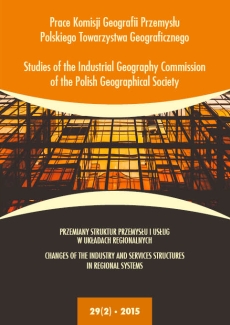Construction as a Factor in the Dynamic Development of the Suburban Area on the Example of Selected Municipalities in the Surrounding Silesian Agglomeration
DOI:
https://doi.org/10.24917/20801653.292.8Keywords:
Silesian agglomeration, construction, rural municipalities, suburban areaAbstract
Rural municipalities included in the suburban area of larger conurbations presently play an important role in the settlement system. These are diverse areas where many interesting social and economic effects take place. Along with the continuous development of urban areas, suburban areas are becoming increasingly important due to the transfer of social and economic life to those areas, which is an integral part of the surrounding urban areas. The subject of the work is the construction developing suburban area of a larger conurbation. The aim of this paper is to present the development of new construction works in two municipalities of Silesia: Bobrowniki and Ożarowice located in the central part of Silesia and adjoining towns belonging to the Silesian agglomeration. Source material comprises fieldwork during which an inventory was made of all new residential buildings constructed in the analysed municipalities. An important factor in the development of the construction industry is the price of the land. This issue was raised on the example of prices of building land, including building plots and, in a few cases, empty construction and building plots. Issues within the scope of housing have been discussed in a wider scope. First of all, the dynamics of the development of new housing have been presented. New residential developments have been divided into two groups: single residential buildings and housing estates. The paper aims to present construction as one of the most important factors affecting the development of the suburban area. On the whole area, which is dedicated to this work is done in the increase in the intensity of traffic building. The surge of people, mainly urban, generates an increase in construction traffic. Because of this, the suburban area is constantly changing, gradually gaining features similar to those of a city.
Downloads
Metrics
References
Bański, J. (2008). Strefa podmiejska – już nie miasto, jeszcze nie wieś. W: A. Jezierska-Thole, L. Kozłowski (red.). Gospodarka przestrzenna w strefie kontinuum miejsko-wiejskiego w Polsce. Toruń: Uniwersytet Mikołaja Kopernika, 29–43.
Drobek, W. (2002). Polskie nowe miasta 1977–2001. W: J. Słodczyk (red.). Przemiany bazy ekonomicznej i struktury przestrzennej miast. Opole: Uniwersytet Opolski, 71–84.
Dziewoński, K. (1987). Strefa podmiejska – próba ujęcia teoretycznego. Przegląd Geograficzny, 59(1–2), 55–63.
Jurek, J. (1991). Zmiany struktury społeczno-ekonomicznej wsi w strefie podmiejskiej Poznania. Poznań: Wydawnictwo Naukowe Uniwersytetu Adama Mickiewicza w Poznaniu, 36–39.
Koter, M. (1985). Kształtowanie się strefy podmiejskiej w świetle badań historyczno-geograficznych. Acta Universitstis Lodziensis, Folia Geographica, 5, 61–73.
Liszewski, S. (1987). Strefa podmiejska jako przedmiot badań geograficznych. Próba syntezy. Przegląd Geograficzny, 59(1–2), 65–79.
Maik, W. (1985). Charakterystyka strefy podmiejskiej w kategoriach funkcjonalnych próba rekonstrukcji modelu pojęciowego i metody badawczej. Acta Universitstis Lodziensis, Folia Geographica, 5, 41–60.
Pryor, R. (1968). Defining the Rural – Urban Fringe, Social Forces. Chapel Hill: University of North Carolina Press, 47(2), 202–215.
Sitek S., Runge, J. i inni (2013). Społeczno-gospodarcze i przestrzenne kierunki zmian regionalnego oraz lokalnych rynków pracy województw śląskiego – SGP WSL. Raport końcowy. Sosnowiec: Wydawnictwo Uniwersytetu Śląskiego.
Staszewska, S. (2006). Miasto czy wieś – uwarunkowania rozwoju i zagospodarowanie podmiejskich jednostek osadniczych. W: K. Heffner, T. Marszał Małe miasta – studium przypadków. Łódź: Uniwersytet Łódzki, 61–73.
Downloads
Published
How to Cite
Issue
Section
License
Articles are published under the terms of the Creative Commons License (CC BY-ND 4.0; Attribution– NoDerivs).

